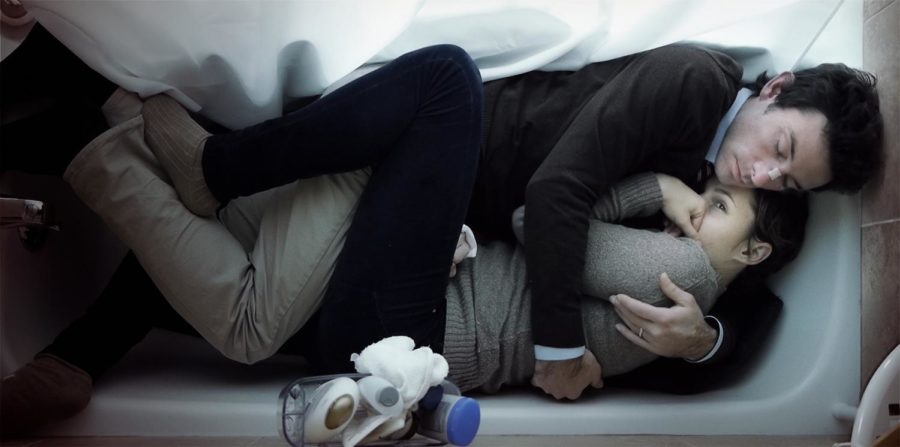Upstream Color is only Shane Carruth’s second feature film since he broke into the scene with 2004’s cult classic Primer, a hyper-realistic time travel narrative made on a $7,000 budget. Upstream Color is a similar feat in ambitious filmmaking, since Carruth was the movie’s director, writer, cinematographer, music composer, camera operator, and chief editor. He also acted as one of the two leads—and he’s self-distributing the film. As with Primer, Carruth has succeeded in creating a rich and special film that necessitates repeat viewings simply to understand what it all means.
Carruth was on the stage of the Music Box Theatre last Friday for the movie’s Chicago premiere to take audience questions. It is a testament to the type of movie this is that attendees asked questions not just related to filming logistics or plot points. One audience member felt the need to comment, sincerely curious, “I was wondering if you have a story, like, in your brain before you start shooting.”
Upstream Color does have a story. Its problem is that it is communicated in a different way than any movie you are likely to have experienced. Carruth’s ultimate goal is to experiment with the storytelling ability of film as a medium, and with Upstream Color he has attempted to communicate a message as nonverbally as possible.
“Upstream is veiled because everything has to be so nonverbal,” Carruth said. To compensate for the limited dialogue of the movie, he has saturated his film with scenes of vibrant color and heady noise and music, which he calls “compositions of communication.”
To explain the significance of the film’s nonverbal exposition necessitates going into the plot. Before continuing, however, I would like to argue that this film is best experienced, at least on first watch, with as little knowledge of the plot as possible. Upstream Color is engaging and rewarding in its gorgeous visuals and technical mastery alone, and is rare in that it permits and encourages the viewer to engage with it while living apart from it, to exit the theatre without immediately understanding the grand message or meaning of the work, and to be OK with that.
The plot of the film functions much like a thought experiment. The character who lives this thought out in the film is Kris (Amy Seimetz), a woman who is one day abducted in the back of a bar and drugged with a concoction created from speciallycultivated maggots. The psychoactive effects of the drug strip away one’s individual will (as in hypnosis). Under her abductor’s spell, Kris, in a trance, feverishly transcribes the entire text of Walden, folding the pages one at a time into a long paper chain. The text becomes one of the movie’s main symbolic references, and many of Thoreau’s descriptions of the natural world at Walden Pond find their visual equivalent in the film.
The effects of her abduction and abuse are emotionally and physically devastating. By the end, she has been stripped of all identity and perhaps possibilities of ever developing or regaining one—she loses her job, her body is mutilated, and her own memories become unfamiliar. According to Carruth, the plot seems veiled only because it is nonverbal, and it must be unspoken because Kris is unable to verbalize her situation, or the grief and loss she undergoes.
However, the message of the film is not entirely psychological: The sci-fi horror of the first half transforms into contemplative spiritual meditation in the second. Kris, isolated and silent, eventually meets Jeff (Carruth), a stranger who seems to have undergone the same ordeal. Though their meeting on a train is a classic happy accident, their relationship avoids typical rom-com tropes; they seem drawn into one another’s lives as if pulled by a force greater than and outside of themselves. Both have experienced great loss, and their relationship is a demonstration that we can love without understanding either ourselves or the object of our love—or perhaps that love can be found within this absence.
Throughout the movie, a slow revelation unfolds: The well-traveled toxin affecting Kris has ingrained within her very nature a connection to objects and places she has never before seen or experienced. Images of material as apparently arbitrary as a pregnant female pig and the ambiguous character of a pig farmer serve to punctuate the film, and in some liminal way, shape the direction it takes. It is a credit to Carruth that he makes this narrative believable throughout the whole length of the film, and despite all the ambiguity and tragedy, that it might conclude with an inspiring message—the source of our sense of loss is also the opportunity to find remarkable comfort in unexpected and seemingly unremarkable matter, like a pig or a blue flower. Upstream Color transforms into a narrative not necessarily about any of its characters, sounds, images or objects, but about the poison and color that bleeds through and connects them all.









